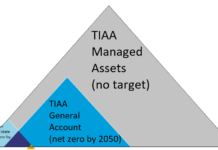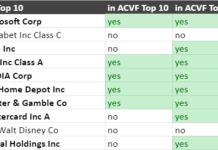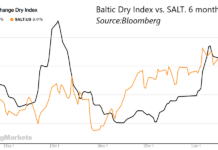When I first came across ProShares’ UltraShort ETFs, I thought they were a brilliant idea. They seem to promise a multitude of advantages for investors:
- The ability to hedge market or sector exposure without having to go short. (Going short requires a margin account, and US law prohibits the use of margin in most retirement accounts.)
- They should have a better risk profile than shorting. With an UltraShort, you can’t lose more than your initial investment. With true shorting, the potential losses are unlimited. As the underlying index rises, each percentage gain creates a smaller dollar fall, while successive declines in the market index should produce successively greater gains.
- They should tie up less capital than Short ETFs for a similar effect.
- Unlike with option strategies, there is no need to choose an option expiration date by which the market move will have occurred.
Unfortunately, it’s not so simple. All Short, UltraShort, and Leveraged ETFs under-perform the seemingly equivalent long or short position in the underlying index, and the underperformance will be worse the greater the leverage and the more volatile the underlying index. This is stated in the prospectus, but the fund sponsors understate the magnitude of the problem.
I’m far from the first person to write about this. In fact, I made the mistake of including an UltraShort ETF in my 10 Clean Energy Stocks for 2009 as one option for a market hedge, because I feel that the downside risks for the market as a whole this year outweigh the upside potential, and I expect that many of my readers may not be using margin accounts. The other possible hedge I mentioned was to "reduce the allocation to large cap stocks" elsewhere in the portfolio. In some ways, my inclusion of SDS in the list was fortunate, because a commenter trashed UltraShorts, and brought the problem to my attention.
The Bad, The Worse, and the Appalling
Others have done a decent job of explaining why leveraged funds underperform, as well as looking at the evidence in the historical data, but despite considerable time on the subject with Google, I have not seen any quantification of the penalty an investor in these funds will pay. So I did an experiment. I put together a spreadsheet which randomly generates a year’s worth (200 trading days) of data from an index for which the daily percentage move follows a normal distribution, except the last 10 days which are calculated to bring the index back to its starting value.
I recalculated my spreadsheet about 30 times each for 1%, 2%, 3%, 4%, and 5% standard deviation of the distribution of percentage changes in the underlying index. The table below shows the range of percentage losses I observed for each type of leveraged ETF. I was a bit surprised to note that Short ETFs and Ultra (x2) ETFs had approximately the same underperformance, while UltraShort (x-2) and Triple (x3) leveraged ETFs also seemed to have the same long term underperformance/frictional losses.
Mostly, I was appalled.
| Standard Deviation of Daily Index Returns |
1 Year Leveraged ETF Underperformance / Frictional Losses |
|||
| Short (x-1) and Ultra (x2) | Ultrashort (x-2) and Triple (x3) | |||
| Min | Max | Min | Max | |
|
1% |
1% | 4% | 4% | 8% |
| 2% | 7% | 13% | 18% | 26% |
| 3% | 14% | 24% | 34% | 53% |
| 4% | 24% | 43% | 64% | 74% |
| 5% | 32% | 60% | 67% | 96% |
Examples
I feel the need to give examples of how to read the above table, because some readers might suspect that they don’t understand the results. I did the calculations myself, and I can barely believe them.
Based on data from October 22, 2008 to January 26, 2009, the S&P 500 had a daily standard deviation of 3.62%. If you were to invest in SDS, an UltraShort ETF which has the S&P 500 as its underlying index, and were to hold it for a year, you should expect to lose between 34% and 74% of your money, if the S&P 500 is flat for that period. This assumes that there are no transaction costs, and that the expense ratio is 0% (in fact, it’s 0.91%.) My experiment also assumed that daily stock market returns follow a normal distribution. In fact, the the distribution of daily stock market returns is leptokurtotic (it has fat tails.) According to my mathematical intuition (the Ph.D. is in math, in case you were curious,) if I had performed the experiment with a leptokurtotic distribution, the losses would have been larger. Obviously, this could be checked, but the results are bad enough as it is.
To put this another way, if your frictional losses were in the middle of the 34-74% range (55%, including the expense ratio,) the S&P 500 would have to drop 27.5% (=55%/2), for you to just break even. In 2008, the S&P 500 fell 39%. If you wanted to make a profit by buying SDS on January 1, and holding it until the end of December, the S&P 500 would have to fall from $903 on January 1 to below $654 by the end of the year. You would do much better (by limiting your potential losses and making profits on a smaller drop in the S&P 500) by buying December 2009 puts on SPY, an unleveraged ETF which tracks the same index.
It simply does not make sense to hold these funds for anything more than a few days (if that.) The S&P 500 is one of the least volatile indexes around, so the example above is a mild one. One reader of my recent crude oil speculation article suggested that I use DXO (an Ultra) or ERX (a Triple) instead of OIL. Using historical data from October 23
, 2008 through January 28, 2009, the daily volatility of OIL was 5.18%, implying a 67% to 96% loss in ERX over the course of a year if crude oil prices do not rise. Although I expect oil prices are headed up, I’m not willing to bet it will happen in the next couple of weeks (over which time an investor in ERX might expect to lose 1-2% if crude prices did not rise.)
It is worth noting that current volatility is much higher than it has been historically. However, volatility always goes up in bear markets, precisely the time I would want to use these as a hedge.
What Can You Do?
Short and UltraShort ETFs are not appropriate for creating a long (or medium) term hedge. In a brokerage IRA, the only effective hedging option I can think of is to purchase long-term puts, or to sell covered calls on the positions in the account. Both these strategies require option trading authority, which most brokerages will grant to experienced or knowledgeable investors.
I have avoided buying puts in the past because they, too, lose value over time. However, if hedging is important to you, the time-value loss can be minimized by buying deep in-the-money puts, at the expense of tying up capital and increasing your potential losses. Selling covered calls is a strategy I use frequently, but this is more of an income-producing strategy. The potential of covered calls to offset a large loss is limited.
If you can, however, it’s probably better to create a hedge for the positions in your IRA in a taxable margin account, where many more tools are available.
Tom Konrad, Ph.D.
DISCLAIMER: The information and trades provided here and in the comments are for informational purposes only and are not a solicitation to buy or sell any of these securities. Investing involves substantial risk and you should evaluate your own risk levels before you make any investment. Past results are not an indication of future performance. Please take the time to read the full disclaimer here.









Tom, Thank you for your advice. I’ve been reading more and more about the danger of the leveraged ETF’s and unfortunately I have experienced this danger and lost money.
Others led me astray as I wanted a hedge.
Its my first year managing my own IRA and I will learn from my mistakes. Your input is much appreciated.
You’re welcome. I wonder how long these ETFs will stay around, or if most will close as people pull thier money out. They’re seductive in the beginning, but now the only use I see for them is shorting them.
Hi Tom,
I don’t have a head for the math modeling, but my benchmark is past performance. And judging by that, these bull and bear oil ETFs do seem to deliver quite accurately (with allowances for currency exchange fluctuations in the case of the Canadian ETFs):
link to chart
ERX is the only one that doesn’t seem to track OIL accurately.
Thanks for your great blog.
Syd
Syd-
The problem is, these ETFs are tracking different underlying indecies, and because the indecies are based on different baskets of futures contracts, they are not really comparable.
When comparing these ETFs, stick to pairs from the same family, i.e. DTO and DXO -or- HOD.TO and HOU.TO.
Then you see the problems… DTO is up 8.4x, but DXO is down 10x, HOD is up 10x, but HOU is down 30x.
Tom,
What do you make of all the tax trap talk going around about using leveraged ETF’s in IRAs? I stuck a link in the URL box to and article on TheStreet “Tax Traps for IRA Investors in Short ETFs” By Holmes R. Osborne III.
I’ve gone crazy readng “yes” and “no” articles around the web suggesting that these funds may all generate Unrelated Business taxes and penalties, the worst of which would be invalidating your whole IRA account as a prohibited transaction and forcing you to take the whole account as an early distribution.
The law seems awfully unclear.
Morris
Morris,
Sounds like another really good reason not to buy these. I’d say the way to find out would be to read one of the fund’s prospectuses; this is the type of thing they’d have to disclose. Better yet, stop straining your brain, and buy puts if you need a hedge in your IRA (you have to get options permission, but this is at least a relatively tried and true practice.